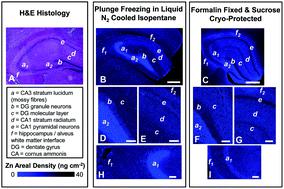当前位置:
X-MOL 学术
›
J. Anal. At. Spectrom.
›
论文详情
Our official English website, www.x-mol.net, welcomes your feedback! (Note: you will need to create a separate account there.)
Sample preparation with sucrose cryoprotection dramatically alters Zn distribution in the rodent hippocampus, as revealed by elemental mapping
Journal of Analytical Atomic Spectrometry ( IF 3.4 ) Pub Date : 2020-08-19 , DOI: 10.1039/d0ja00323a M J Pushie 1 , A Hollings 2, 3 , J Reinhardt 4 , S M Webb 5 , V Lam 2, 6 , R Takechi 2, 6 , J C Mamo 2, 6 , P G Paterson 7 , M E Kelly 1 , G N George 8, 9 , I J Pickering 8, 9 , M J Hackett 2, 3
Journal of Analytical Atomic Spectrometry ( IF 3.4 ) Pub Date : 2020-08-19 , DOI: 10.1039/d0ja00323a M J Pushie 1 , A Hollings 2, 3 , J Reinhardt 4 , S M Webb 5 , V Lam 2, 6 , R Takechi 2, 6 , J C Mamo 2, 6 , P G Paterson 7 , M E Kelly 1 , G N George 8, 9 , I J Pickering 8, 9 , M J Hackett 2, 3
Affiliation

|
Transition metal ions (Fe, Mn, Cu, Zn) are essential for healthy brain function, but altered concentration, distribution, or chemical form of the metal ions has been implicated in numerous brain pathologies. Currently, it is not possible to image the cellular or sub-cellular distribution of metal ions in vivo and therefore, studying brain-metal homeostasis largely relies on ex vivo in situ elemental mapping. Sample preparation methods that accurately preserve the in vivo elemental distribution are essential if one wishes to translate the knowledge of elemental distributions measured ex vivo toward increased understanding of chemical and physiological pathways of brain disease. The choice of sample preparation is particularly important for metal ions that exist in a labile or mobile form, for which the in vivo distribution could be easily distorted by inappropriate sample preparation. One of the most widely studied brain structures, the hippocampus, contains a large pool of labile and mobile Zn. Herein, we describe how sucrose cryoprotection, the gold standard method of preparing tissues for immuno-histochemistry or immuno-fluorescence, which is also often used as a sample preparation method for elemental mapping studies, drastically alters hippocampal Zn distribution. Based on the results of this study, in combination with a comparison against the strong body of published literature that has used either rapid plunge freezing of brain tissue, or sucrose cryo-protection, we strongly urge investigators in the future to cease using sucrose cryoprotection as a method of sample preparation for elemental mapping, especially if Zn is an analyte of interest.
中文翻译:

用蔗糖冷冻保护的样品制备显着改变了啮齿动物海马体中锌的分布,如元素图所示
过渡金属离子(Fe、Mn、Cu、Zn)对于健康的大脑功能至关重要,但金属离子的浓度、分布或化学形式的改变与许多大脑病变有关。目前,不可能在体内对金属离子的细胞或亚细胞分布进行成像,因此,研究脑金属稳态在很大程度上依赖于离体原位元素映射。如果希望转化离体测量的元素分布的知识,那么准确保存体内元素分布的样品制备方法是必不可少的加深对脑部疾病的化学和生理途径的了解。样品制备的选择对于以不稳定或移动形式存在的金属离子尤为重要,对于这些金属离子,体内不适当的样品制备很容易扭曲分布。研究最广泛的大脑结构之一,海马体,含有大量不稳定和可移动的锌。在本文中,我们描述了蔗糖冷冻保护(制备用于免疫组织化学或免疫荧光的组织的金标准方法,也经常用作元素作图研究的样品制备方法)如何彻底改变海马中的锌分布。根据这项研究的结果,结合已发表的大量使用脑组织快速冷冻或蔗糖冷冻保护的文献进行比较,我们强烈敦促研究人员在未来停止使用蔗糖冷冻保护作为一种用于元素映射的样品制备方法,尤其是当 Zn 是目标分析物时。
更新日期:2020-08-19
中文翻译:

用蔗糖冷冻保护的样品制备显着改变了啮齿动物海马体中锌的分布,如元素图所示
过渡金属离子(Fe、Mn、Cu、Zn)对于健康的大脑功能至关重要,但金属离子的浓度、分布或化学形式的改变与许多大脑病变有关。目前,不可能在体内对金属离子的细胞或亚细胞分布进行成像,因此,研究脑金属稳态在很大程度上依赖于离体原位元素映射。如果希望转化离体测量的元素分布的知识,那么准确保存体内元素分布的样品制备方法是必不可少的加深对脑部疾病的化学和生理途径的了解。样品制备的选择对于以不稳定或移动形式存在的金属离子尤为重要,对于这些金属离子,体内不适当的样品制备很容易扭曲分布。研究最广泛的大脑结构之一,海马体,含有大量不稳定和可移动的锌。在本文中,我们描述了蔗糖冷冻保护(制备用于免疫组织化学或免疫荧光的组织的金标准方法,也经常用作元素作图研究的样品制备方法)如何彻底改变海马中的锌分布。根据这项研究的结果,结合已发表的大量使用脑组织快速冷冻或蔗糖冷冻保护的文献进行比较,我们强烈敦促研究人员在未来停止使用蔗糖冷冻保护作为一种用于元素映射的样品制备方法,尤其是当 Zn 是目标分析物时。



























 京公网安备 11010802027423号
京公网安备 11010802027423号